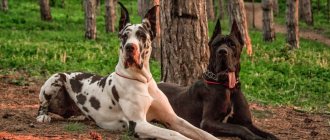No matter how much we love and are attached to our smaller brothers, unfortunately, sooner or later, like all living beings, animals go to another world. Death, even in relation to dogs, is a truly sad reality that all, without exception, breeders of these beautiful creatures devoted to us will have to face. But so that the death of a pet does not become a sudden blow, we will consider the signs of approaching extinction, by which you can understand that the dog is dying. Perhaps this knowledge will at least help you mentally prepare for the calm departure of your beloved dog.
What do dogs die from?
The appearance of a pet in the house is not only a joyful, but a responsible event. From the first days, the pet needs proper systematic care, attention, care and love.
Important! The duration and quality of life of our little brothers largely depends on the actions and attitude of the owner and family members towards the animal.
We need to understand that our pets live much shorter lives than people. The average lifespan of a dog is 10-13 years. There are cases where dogs lived up to 17-18 years. But these indicators are individual for each specific animal and the life of a pet can end at any moment.
At the same time, representatives of large, giant, medium breeds can live only 9-11 years, small dogs live 12-14 years. Life expectancy depends not only on the breed, but also on many other reasons (care, health status).
Dogs die:
- from old age;
- viral-bacterial, infectious diseases;
- invasive diseases;
- incurable infections;
- cancer;
- autoimmune, advanced chronic pathologies;
- congenital, genetic abnormalities.
Often the cause of death for dogs is severe injuries, injuries incompatible with life. Puppies, young dogs, unvaccinated pets can die from diseases (viral, bacterial) if treatment is not started in time. However, most diseases of infectious etiology develop at lightning speed, and the dog should be treated immediately after the first symptoms appear. Some diseases can only be cured at an early stage of their development.
Dogs die from poisoning from poisons, potent toxins, chemicals, and medications. Therefore, to prevent this from happening, keep medicines and medicines at home in places inaccessible to dogs, and on walks, make sure that the dog does not pick up crap from the ground.
News from dogs
- The family may hear what sounds like the pet stomping on the steps of a staircase as it climbs up the stairs.
- The quiet scraping of claws on the wooden floors of rooms, hallways or kitchens.
- A whining noise under the door, similar to the whining noise a dog made after a walk, trying to get home.
- Some people quite clearly hear the sound of a bell that used to hang on the collar of their beloved dog.
Typically, these signs indicate that the deceased dog just wants to say hello. A person must understand that this is a sign that clairaudience abilities have opened in him. As a rule, they appear after serious losses of someone close or a pet.
Hiding trash: a painting turns into a table, and other tricks of small houses
Came out with a bouquet of flowers: the girl spoke about the taxi driver who influenced her life
Enchanted Forest: a grove of bizarre redwoods in Northern California
Signs of an old dog
Aging in dogs occurs in much the same way as in humans. The condition of the fur deteriorates, gray hair appears, and the look becomes dull. Elderly, old dogs become less active, move more slowly and more carefully, often refuse active games and outdoor entertainment, and during walks they are practically not interested in the world around them, preferring to lie in silence away from people and animals.
This condition can last from several weeks, months or up to a year, but provided that the animal does not suffer from any pathologies. The dog is quietly fading away, weakening, so be prepared that one day your beloved pet will leave this world.
Important! In addition, you need to understand that chronic, systemic pathologies can worsen in elderly pets. If the dog sleeps poorly, sleeps restlessly, shows restlessness, constantly whines, moans, refuses to eat, or other symptoms are noticeable, this most likely means that the dog is experiencing discomfort and suffering from pain. In this case, the dog can literally fade away before our eyes, especially with oncology.
The main signs of old age in dogs:
- decreased activity, slower movement;
- drowsiness, lethargy, depression;
- weak reaction to external stimuli;
- heart rhythm disturbance;
- decreased visual acuity;
- deterioration of coat condition;
- changes in behavior;
- violation of movement coordination;
- sudden weight loss;
- decreased appetite;
- change in taste preferences;
- frequent urination, defecation, unstable stool.
Pet perfumes
The spirits of pets in the form of some signs can visit not only a righteous believer, but also a convinced skeptic. That's why we need to talk about it. And the signs will appear in the feeling of the presence of a cat or dog in the house, in a real vision of a fluffy, touching his fur, inhaling the smell of his food...
In the film “All Dogs Go to Heaven,” the main idea is the understanding that being “on the other side” of life, a pet will definitely come to the one it loved during life.
“I will invite wealth into the house”: at Epiphany I perform a ritual with holy water and coins
Air quality due to the pandemic is not as good as previously thought
A number of scientists believe that the coronavirus could have been artificially created in a laboratory
There are several common types of visits your beloved pet may receive. Some of them are documented, others were told by mediums, others are part of the family history of some people.
Other signs and manifestations of an aging dog
A sure sign of approaching old age in animals is a decrease in appetite . A dog that had an excellent appetite and constantly begged for treats from its owner may periodically refuse food or constantly be undernourished from its usual portion size.
Even if the owner gives his favorite treat, the dog may refuse it, but as a sign of gratitude he will lick the owner’s tidbit or hand. This condition is explained by a decrease in the body’s energy needs, as well as a slowdown in metabolism. Do not force your pet to eat or try to force feed the animal.
After eating, older dogs may develop metabolism, bloating, belching, and hiccups. It is not uncommon for dogs to vomit some of the food they eat after eating. Do not forget that due to age-related changes, the functioning of internal organs and systems is disrupted.
In the gastrointestinal tract, with age, the number of enzymes that take part in the digestion and absorption of food decreases, and the number of beneficial intestinal bacteria decreases. Therefore, after eight years, veterinarians recommend nutritional adjustments.
The diet should consist of easily digestible nutritious food. If your dog is kept on ready-made industrial complete food, purchase products marked “For old, elderly” premium, super-premium animals.
In older dogs, there is a frequent urge to urinate and uncontrolled emptying of the bladder. At the same time, even if the dog asks to go for a walk, the pet can relieve itself at home or in the entrance, and it is strictly forbidden to scold the dog for this.
In aging dogs, unstable bowel movements (constipation, diarrhea) are common. The process of defecation can cause discomfort and be accompanied by pain.
Pay attention to your gait. Older, older dogs move more slowly and carefully. In some pets, you may notice an unsteady gait, frequent involuntary muscle spasms, and convulsions.
Sometimes there is a weakening of tongue control. In this case, the dog’s mouth is constantly open, the lower jaw hangs, and saliva flows.
In dogs, chronic diseases, pathologies, and illnesses become more acute. Representatives of large breeds are diagnosed with joint diseases, muscle weakness, and ophthalmological and endocrine diseases are identified.
How to awaken an animal's appetite
If the cause of loss of appetite is any disease, you need to take the animal to the doctor as soon as possible. You should not waste precious time if, in the absence of appetite, the dog exhibits other dangerous symptoms: refusal to drink, increase or decrease in body temperature, discharge from the nose or eyes, problems with coordination of movements, vomiting and diarrhea (there may be impurities in the form of blood, pus, mucus), constipation, and other signs of ill health.
However, if the animal is starving not due to health problems, then the owner can try to take the following actions:
- Take long and active walks in the fresh air
. As a rule, after such promenades the dog has an excellent appetite; - During a walk, many owners treat their dogs to something tasty
(for example, meat biscuits). If an animal eats too many of these treats, then at home it will most likely eat poorly (or refuse to eat at all); - Make the dog menu varied
. There are owners who feed their pets the same thing every day. But why not bring something new to the animal menu? For example, chicken that is familiar to a dog can be replaced with beef or offal at least 1-2 times a week. Instead of the regular carrots, you can put pumpkin or zucchini in the bowl; - Switch the dog to another food
. If a dog refuses to eat ready-made food, it means it doesn’t like it. At the pet store you can purchase several small packages of food of different brands in order to choose the one that your animal likes most; - You need to carefully study the animal's diet
. It is highly advisable to exclude the following dishes from the dog menu that can cause harm: candy, chocolate, nuts, grapes, raw eggs, onions, milk, salt, as well as alcoholic beverages, coffee and tea, these are the products that cause particular harm to the dog’s body; - To make sure that the refusal to eat is definitely not caused by illness, the dog needs to be given some kind of treat
. If the dog ate the treat with pleasure, then most likely he does not like his usual food; - Sometimes, in order to arouse interest in food, the animal can be deceived
. To do this, the owner needs to put food in a bowl in front of the dog and pretend that he really wants to eat it (sniff the food, say that it must be tasty, smack his lips a little). There is a possibility that the pet will not want to share its portion of food with the owner; - Salty food awakens the appetite
. And although you shouldn’t spoil your dog with dishes high in salt, sometimes a piece of dried fish can help your pet eat; - It is advisable to feed a dog with poor appetite alone in a quiet room
. It is also important to pay attention to the bowl. First of all, it must be clean. Secondly, its dimensions must correspond to the dimensions of the dog. Thirdly, the bowl must be stable and not fidget on the floor while the pet is eating;
Now let’s look at what the owner of a dog that doesn’t eat well or refuses to eat at all should not do:
- Under no circumstances should you shout at or hit the animal
. Screaming and physical pressure will not help the matter in any way, but they will scare the dog, as a result of which it will definitely not eat; - Also, you should not force feed your dog
by putting pieces of food in its mouth (unless your veterinarian prescribes this); - There is no need to leave uneaten food in a bowl in the hope that the dog will get hungry and eat it either today or tomorrow
. The animal may eat stale and spoiled food, but this can result in food poisoning.
How to understand that a dog is about to die
Unfortunately, the death of pets can occur suddenly, as already noted, due to illness, severe injuries, severe poisoning, or intoxication.
But if the dog is healthy, you can understand that the pet will soon pass into another world and this sad event will happen in the next 24 hours , not only by the changed habits and behavior, but also by the following signs:
- Shallow intermittent breathing. The normal breathing rate of an adult dog is 25=35 breaths per minute. Before death, this figure is 10-12 breaths/min. Gradually, the lungs stop filling, breathing becomes barely perceptible, and when the dog dies, it completely subsides.
- Change in heart rate. The pulse of a dying dog is thread-like and is approximately 55-65 beats/min. In the last hours before the death of the animal, it is practically not palpable.
- Involuntary defecation (diarrhea), urination, vomiting. Very often, before death, animals involuntarily defecate. This is explained by the fact that animals are no longer able to control their body; their muscles are completely relaxed. Vomit and feces contain mucus, foam, particles of undigested food, and bloody substances. The urine is dark in color, and the feces emit an unpleasant, specific odor. The excrement may contain foam, blood, or foreign inclusions. After death, the dog will pee and defecate for the last time due to loss of muscle control.
- Inability to stand up. A few days before death, the dog gets up little and practically does not leave his bedding or house. Disorientation in space and loss of coordination of movements are possible. Often, a pet, trying to get up, falls on its side or immediately squats. In this situation, neither massage, nor rubbing, nor medications will help. The brain gradually dies, loses neural connection with muscle structures and ligaments.
- Complete atrophy of muscle structures. A similar condition is observed in very old dogs, as well as in animals that, due to illness or problems in the musculoskeletal system, have not moved much in recent months. The dog's legs move apart, it is difficult for the dog to hold his head up, and the dog does not get up from the bedding. When palpated, the muscles resemble jelly to the touch.
- Dry skin. Before death, the epidermis loses its elasticity. The skin becomes rough, dry, and does not return to its usual place if it is pulled back. This is explained by dehydration and changes in the structure of collagen fibers. The epidermis may look pale and bluish.
- Loss, clouding of consciousness.
A few days before death, dogs' tactile sensitivity decreases . The dog feels virtually no pain. Moreover, if the animal is sick, to reduce pain, especially with oncology, you need to continue to inject or give the dog analgesics prescribed by the veterinarian.
You may notice involuntary muscle spasms and cramps . Before death, the pet reacts very weakly or absolutely not to external stimuli, regardless of the intensity of their impact. At the same time, it is possible that the dog hears, understands, feels you.
Main features
The following signs will let you know that your dog is about to die. Depending on the situation, these signs will either provide a last chance for salvation, or time to prepare and say goodbye.
Activity is one of the most striking signs of fading vitality, this is a decrease in activity. Out of habit, the dog will ask to go outside, try to endure the toilet, follow the owner’s commands, and behave as usual. However, an observant owner will notice that games and walking do not bring the animal as much pleasure as before. After a walk, the dog will lie down in its place and sleep for a long time, and will not enjoy prolonged communication.
Reflexes – against the background of decreased activity, lethargy and impaired reflexes occur. At first, these violations will not be obvious, but you will notice that the pet tries not to run fast, avoids sudden maneuvers, and often lies down during walks. Even dogs that were cocky in their youth begin to give in to young animals and aggressive relatives. At this moment, it is important to support your pet and try to ensure its maximum safety and self-confidence. If you notice that your dog feels uncomfortable on a walk, consider moving the walk to a more secluded place.
Metabolic slowdown - many dog lovers say that the dog’s appetite worsens in anticipation of death, but this is not always the case. In the process of natural cell degradation and metabolic processes, the following trends can be observed:
- The dog eats well, but does not gain weight.
- The pet independently reduces the daily food intake, but drinks well.
- Despite normal fluid intake, the dog develops dehydration.
- The dog develops vitamin deficiency or a clear deficiency of nutrients.
Weight loss with a normal diet can indicate not only a metabolic disorder, but also a number of diseases:
- With a helminthic infestation, the dog will lose weight, but its appetite will only improve at first. If your pet is elderly and you suspect a helminthic infestation, you should consult your veterinarian about adequate preventive measures. Not all drugs designed to remove worms are designed to take into account the slow metabolism of older animals.
- Weight loss while eating normally may indicate systemic diseases, such as diabetes or other abnormalities in the body. Carefully monitor your pet's condition, since in old age the risk of developing diseases to which the dog is prone increases.
- Skin and coat - against the background of impaired metabolism, a dog may consume the usual amount of water and food, but suffer from a deficiency of microelements or dehydration. One of the most obvious signs of dehydration is poor skin and coat condition. The wool becomes disheveled, loses its natural shine, becomes severely deformed, and breaks. If you look closely at the skin, you may notice a large number of scales or even cracks. However, do not rush to conclusions and take your dog to the vet. This may indicate seborrhea, which most older but still physically strong dogs are prone to.
- Breathing – disruption of the respiratory system – is a clear sign that your pet is about to leave. When metabolic processes slow down critically, the dog falls into a lethargic state. You may notice a slowing in your breathing rate. Depending on the size of the dog, the normal breathing rate varies from 22 to 30 breaths per minute. When breathing slows down, the dog breathes slowly, deeply, often with an open mouth. The breathing rate usually decreases to 10–11 breaths per minute. Just before death, the dog continues to make breathing movements, but in fact it does not inhale or exhale air, since the lungs no longer expand.
- Heart Rate – After slowing down your breathing, you may notice a clear decrease in your heart rate. A healthy dog has a strong pulse with a frequency of 100-130 beats per minute. In a dog whose metabolism is slow, the heart rate drops to 50-80 beats per minute. When the pulse decreases, a natural drop in blood pressure occurs, which is accompanied by severe weakness and apathy. Usually the dog tries to hide in a dark, secluded place, hardly moves, and when trying to move from place to place, the pet sways greatly. At this stage, only the dog’s comfort depends on you; if the pet dies of old age, you can assume that this condition is irreversible. However, be prepared for the fact that the dog may remain in a state of lethargy for a day or even more. There is no need to force your pet to eat, drink, or get up.
- Digestive system - a few days, and maybe hours, before death, the dog will completely refuse food. In this case, the pet may involuntarily empty its intestines and bladder. Even if the dog does not eat anything, feces will remain in the intestines, since the peristalsis of the intestinal walls is greatly reduced. Offer water to your pet, but do not force your dog to drink. Be prepared for the fact that in the last days and hours, the pet will go to the toilet under itself. If the dog gets up and asks to go outside (and this often happens), take it out for a walk in your arms and immediately bring it home. Immediately after death, the dog will have an involuntary and complete emptying of the intestines and bladder. This happens because the muscles completely relax after the death throes.
- Mucous membranes - against the background of dehydration, metabolic disorders, and nutritional deficiency, the dog may develop oxygen starvation of cells. At first, you may not notice anything other than a change in the color of the mucous membranes of the eyelids and gums. Typically, the gums become gray, whitish, or almost transparent. Try to measure your pet's temperature; if it is low, provide the dog with warmth. When the temperature naturally drops, the dog experiences chills, and when the animal is cold, it cannot relax - this is a reflex.
About the death agony
Many owners panic when their pet is in its death throes. Fear is caused not even by the loss of a dog, but by the state in which it is interrupted before death. It is important to learn one thing, you cannot change anything, but it depends on you how your pet will feel in the last moments of its life. Keep calm with all your might, don’t cry, hug the animal, calm it down, try not to let your voice tremble.
Yes, these recommendations look cold, they are almost impossible to follow when the pet licks his hands and says goodbye. You may not believe it, but dogs have a presentiment of death, they are afraid of it just like people.
Learn one more truth, your pet devoted his whole life to serving you, he was ready to do anything to make you happy. Try to be happy in the last moments of his life, so that when he leaves, your pet knows that he coped with his task perfectly.
Let's take a break from philosophy, what is the death agony? As mentioned above, a few hours before death the dog falls into lethargy. This state can be described in different ways: indifference, complete calm, tranquility, and so on. From a scientific point of view, lethargy is a partial cessation of the functioning of brain neurons. Being in lethargy, the dog practically does not feel pain, loses its sense of smell and hearing. The last thing a dog loses is its vision and sense of touch, which is why it is so important to be close and constantly in contact with it.
When it comes to death from old age, we can say that death is painless. The pet may feel sick. Nausea in this case is natural and should not be stopped. Try to maintain eye contact with your dog until his pupils dilate and no longer respond to light.
Lack of pupil accommodation indicates complete lethargy or coma. After loss of vision, the dog only feels stroking (and not always), but at the same time the nerve endings of the skin constantly and very rapidly atrophy. No matter how hard it is for you, you need to remember that after the atrophy of the pupils, the dog no longer feels almost anything.
How to help a dying dog
In some cases, if the dog has been suffering from a chronic disease for a long time, supportive therapy, treatment does not produce any results, the animal is in severe pain, the veterinarian will suggest elective euthanasia . This is an easy, quick and painless death. Euthanasia relieves a pet from physical suffering, minimizes the pain and fear of loss of consciousness that animals experience before death.
Euthanasia is carried out by veterinarians in cases of cancer, the presence of multiple serious injuries incompatible with life (head injuries), as well as in the case of diagnosing incurable infections (rabies, Aujeszky, tuberculosis).
Advice! Whether or not to euthanize a dog is a decision only for the owners. But in many situations this is a more humane method in relation to your beloved dog. It’s really unbearable to watch your pet suffer and you can’t do anything to help him.
To ease your pet's suffering and pain, constantly monitor its behavior. Surround your dog with care and proper care. If the animal dies easily, provide it with peace and quiet. Try not to leave your dog's side. This way the dog will feel more comfortable and calm in the last moments of his life.
Why do dogs run away from home before they die?
It is believed that dogs and cats sense their approaching death. If the dog is strongly attached and devoted to its owner and family members, in the last days of its life the dog will constantly be near its owner, literally following on its heels. Pay attention to your beloved pet, try to make his last days and hours as pleasant and comfortable as possible. Surround your dog with love, affection, warmth.
It happens that dogs, sensing approaching death, run away from home. There are several versions explaining this behavior of a pet. Some experts agree that dogs run away from home because they sense the anxious state of their owners. But by and large this is not true. Although dogs can recognize our emotional state, in order to do this, you need to have human consciousness. Moreover, for animals, life and death are equally natural.
Most biologists agree that a dog's escape from home before its death is explained by the same reasons as the departure of a sick old wolf from the pack. In recent days, dogs have become clouded in their consciousness, the skills instilled in the process of communicating with humans are forgotten, but at the same time their natural instincts are activated. It is because of this that dogs, overcoming weakness, try to get as far away from home as possible.
Important! But if the dog has retained consciousness and is very strongly attached to its owner, it will spend its last days with members of its pack and will be left to die in the house or in the arms of its owner. Don't regret your free time, spend it with your beloved dog, stay with the animal as much as possible.
After your dog passes away, you will long remember the pleasant moments from communicating with your dog. Perhaps a new pet will help reduce the pain of losing a devoted, loyal friend. A restless, funny puppy will again fill the house with joy, positivity and help avoid depression caused by the death of a beloved dog. Decide on the breed and give the dog a new name.
Signs after the death of a dog
If the dog dies, many people sincerely believe that there are a number of signs that should be observed. In particular, you should not bury a deceased dog near your home, as this will bring failure in the family or the imminent death of one of your relatives.
If you want to get a new pet to replace the lost one, it is not recommended to do this before 2 months have passed. This is due to the belief that a puppy can suddenly get sick and die.
In ancient times, it was customary to burn a person’s dead friends. This was done so that the spirit of the beast could not rise from the grave and harm other pets. Although this could rather be explained by the fact that the burned corpse did not become a breeding ground for viruses and diseases.
Whether to believe in all these signs or not is everyone’s business. One thing is for sure - after the death of a pet, it must be buried. Moreover, in such a way that it does not get washed away during the rain and other homeless animals do not get to it.
It is best to take the dog somewhere outside the city, where there are no prying eyes. Regardless of the breed, a devoted friend needs his own grave. What you definitely shouldn't do is throw the corpse in the trash.
At the hour of death, a faithful friend needs his owner especially strongly. It’s worth remembering how much joy and fun the dog has brought to a person over all the past years and just being with him. After all, for a person he is just an episode in life, but for a pet, the owner is his whole life.











